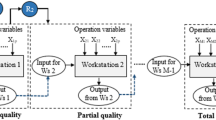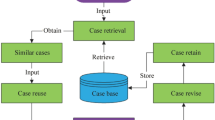Abstract
In this paper, a new data mining algorithm based on the rough sets theory is presented for manufacturing process control. The algorithm extracts useful knowledge from large data sets obtained from manufacturing processes and represents this knowledge using “if/then” decision rules. Application of the data mining algorithm developed in this paper is illustrated with an industrial example of rapid tool making (RTM). RTM is a technology that adopts rapid prototyping (RP) techniques, such as spray forming, and applies them to tool and die making. A detailed discussion on how to control the output of the manufacturing process using the results obtained from the data mining algorithm is also presented. Compared to other data mining methods, such decision trees and neural networks, the advantage of the proposed approach is its accuracy, computational efficiency, and ease of use.
Similar content being viewed by others
References
Ruggieri S (2002) Efficient C 4.5. IEEE Trans Knowl Data Eng 14(2):438–444
Cantu-Paz E, Kamath C (2003) Inducing oblique decision trees with evolutionary algorithms. IEEE Trans Evol Comput 7(1):54–68
Breiman L, Friedman JH (1984) Classification and regression trees. Wansworth International, Belmont, CA
Quinlan JR (1986) Induction of decision trees. Mach Learn 1:81–106
Quinlan JR (1993) C4.5: programs for machine learning. Morgan Kaufmann, San Mateo, CA
Murthy SK (1998) Automatic construction of decision trees from data: a multidisciplinary survey. Data Mining Knowl Discovery 2:345–389
Kusiak A (2000) Decomposition in data mining: an industrial case study. IEEE Trans Electr Packag Manuf 23(4):345–353
Mehta M, Agrawal R, Risanen J (1996) SLIQ: a fast scalable classifier for data mining. In: Proceedings of the Fifth International Conference on Extending Database Technology, Avignon, France
Shafer J, Agrawal R, Mehta M (1996) SPRINT: a scalable parallel classifier for data mining. In: Proceedings of the International Conference on Very Large Databases, Morgan Kaufmann, pp 544–555
Gehrke JE, Ramakrishnan R, Ganti V (2000) RainForest – a framework for fast decision tree construction of large datasets. Data Mining Knowl Discovery 4:127–162
Tickle B, Andrews R, Golea M, Diederich J (1998) The truth will come to light: directions and challenges in extracting the knowledge embedded within trained artificial neural networks. IEEE Trans Neural Netw 9:1057–1068
Lu HJ, Setiono R, Liu H (1996) Effective data mining using neural networks. IEEE Trans Knowl Data Eng 8:957–961
Zhang GP (2000) Neural networks for classification: a survey. IEEE Trans Syst Man Cybernetics 30(4):451–462
Ripley BD, Ripley RM (1998) Neural networks as statistical methods in survival analysis. In: Dubrowski R, Gant V (eds) Artificial Neural Networks: Prospects for Medicine, Landes Biosciences Publishers, Georgetown, TX, pp 1–13
Baxt WG (1995) Applications of artificial neural networks to clinical Medicine. Lancet 346:1135–1138
Ostermark R (1997) A fuzzy neural network algorithm for multigroup Classification. Fuzzy Sets Syst 105:113–122
Hemsathapat K, Dagli CH, Enke D (2001) Using a neuro-fuzzy-genetic data mining architecture to determine a marketing strategy in a charitable organization’s donor database. In: Proceedings of the IEEE International Engineering Management Conference, Albany, NY, pp 64–69
Pawlak Z Rough sets and decision analysis. INFOR 38(3):132–143
Pawlak Z (1991) Rough sets – theoretical aspect of reasoning about data. Kluwer, Dordrecht
Pawlak Z (1982) Rough sets. Int J Comput Inf Sci 11:341–356
Kusiak A, Kurasek C (2001) Data mining of printed-circuit board defects. IEEE Trans Robot Automat 17(2):191–197
Kusiak A, Law IH, Dick M (2001) The G-algorithm for extraction of robust decision rules – children’s postoperative intra-atrial arrhythmia case study. IEEE Trans Inf Technol Biomed 5(3):234–255
Ohrn A, Ohno-Machado L, Rowland T (1998) Building manageable rough set classifiers. In: Proceedings of the AMIA Symposium, pp 60–64
Kusiak A, Kern JA, Kernstine KH, Tseng BT (2000) Autonomous decision-making: a data mining approach. IEEE Trans Inf Technol Biomed 4(4):274–285
Das-Gupta P (1988) Rough sets and information retrieval. ACM Press, New York, pp 567–581
Kanungo T, Netanyaho NS, Wu AY (2000) An efficient k-means clustering algorithm: analysis and implementation. IEEE Trans Pattern Anal Mach Intell 24(7):887–892
Han J, Kamber M (2001) Data mining – concepts and techniques. Morgan Kaufmann, San Francisco, CA
Mohanty PS, Allor R, Lechowicz P, Parker R, Craig J (2003) Particle temperature and velocity characterization in spray tooling process by thermal imaging technique. Therm Spray ASM, pp 1183–1190, May, Orlando, FL
Author information
Authors and Affiliations
Corresponding author
Rights and permissions
About this article
Cite this article
Sadoyan, H., Zakarian, A. & Mohanty, P. Data mining algorithm for manufacturing process control. Int J Adv Manuf Technol 28, 342–350 (2006). https://doi.org/10.1007/s00170-004-2367-1
Received:
Accepted:
Published:
Issue Date:
DOI: https://doi.org/10.1007/s00170-004-2367-1




